Delicate yet resilient, Cyclamen are winter beauties that will only thrive year-round if given proper attention. With its heart-shaped leaves and vibrant blooms, Cyclamen care is all about understanding its seasonal needs.
In this guide, I will share how to care for a cyclamen planted indoors and outdoors. Jump in and walk through the essentials of keeping this balcony garden plant happy and blooming.
Cyclamen Care – An Elaborative Care Guide
Caring for a cyclamen plant indoors and outdoors requires patience and understanding of its seasonal needs. With the right balance of sunlight, water, and temperature, Cyclamen care can be easy, and you can witness blooming spring flowers in your garden space.
| Sunlight Exposure: During winter, bright and indirect sunlight works best for the plant. In summer, when the plant is dormant, try placing the pot indoors in a cool, dry spot with good air circulation. |
| Water Needs: Frequent watering is needed during the initial growing stages, only to keep the soil moist. Once the plant is established, adjust the frequency to avoid waterlogging. |
| Soil Type: Prefers growing in organically rich, permeable soil type, which is slightly acidic in nature. If you are planning to grow it as a low-light indoor plant, try using a regular potting mix. |
| Temperature and Humidity: Cyclamen plants cannot thrive in extreme heat zones. They prefer growing in areas having temperatures between 40°F and 50°F at night and 60°F and 70°F during the day. It is important to provide high humidity to the plant, especially during winter. |
| Fertilizer: A diluted liquid fertilizer with a low nitrogen level works best in the Cyclamen plant care. Do not fertilize the plant when it’s dormant, as it can damage the stem of the plant. |
Mastering Cyclamen plant care is all about being attentive and following the accurate care guide. By providing the plant with the ideal growing conditions, you can witness lush foliage in no time.
Cyclamen Plant Care: Potting, Repotting, and Propagating
When it comes to Cyclamen care, understanding its potting, repotting, and propagation needs is essential for healthy growth and continuous blooming. This delicate flower will reward you with lush greenery if grown under ideal conditions.
Potting
If you are seeking answers to how to look after a cyclamen, let me tell you, following the accurate potting method is one of the steps. I always begin by choosing a pot that’s slightly larger than the tuber and has excellent drainage.
Make sure to use equal parts of peat, perlite, and potting mix to ensure optimal growth. The tuber should be placed just below the soil surface, ensuring it is not buried too deeply to prevent root rot.
Pro Tip: Keep the pot in a cool, dry, and shady spot away from direct sunlight. Overwatering should be avoided. The soil should be slightly moist but never soggy.
Repotting
Cyclamen generally needs repotting every 1–2 years, usually after their dormant period. I gently remove the tuber, clean off old soil, and inspect for any signs of root rot or pest infestation. A fresh potting mix helps rejuvenate the plant and promote healthy growth for the next blooming season.
You can also trim all the dead roots or overgrown roots for easy potting. Tickle or loosen them to improve air circulation, and always repot the plant in a pot that is at least 10% taller and wider than the previous one.
Pro Tip: Always handle the tuber carefully while repotting Cyclamen and avoid disturbing the roots too much during the process.
Propagation
This process can be done through the seeds or division of tubers. I personally prefer them growing from seeds, which I sow in moist soil in a shaded area during late summer. Cover the seeds with a fine layer of soil mix, sand, or fine grit.
Germination takes about 4–6 weeks. For the tuber division, mature tubers can be carefully split into sections, each having a growth node, and should be replanted in fresh soil.
Pro Tip: Propagation requires patience. Note that a new flower might also take a year or more to flower.
Proper potting, timely repotting, and thoughtful propagation ensure a strong base for a thriving Cyclamen plant. It is also important to understand its natural growth cycle and ideal growing conditions to have a vibrant genus year after year.
Common Pests and Plant Diseases – How to Care for Cyclamen?
Though it is a low-maintenance species, caring for cyclamens indoors or outside is not entirely easy. Even the most well-cared-for Cyclamen plants are prone to different kinds of pests and plant diseases. Recognizing them at early stages prevents any kind of serious damage and ensures long-lasting blooms.
Here are some common pests and plant diseases that can affect the health of your Cyclamen, whether indoors or outdoors.
| Cyclamen Mites: The name Cyclamen mites derives from the fact that Cyclamen is its primary host. Not clearly visible to the naked eye, these mites are translucent and can cause serious damage to the genus. |
| Leaf Spot: Yellow-brown or grey circular spots on the backside of the leaf. This is a kind of fungal infection and is usually caused by overwatering or poor soil conditions. Consider applying a fungicide for timely treatment. |
| Aphids: Aphids are the most common pest on cyclamen plants. They feed on the stems of the genus and leave a sticky residue on the plant known as honeydew. This causes the leaf to yellow and results in stunted growth. |
| Mealybugs: These can easily be spotted due to the cotton-like residue they leave on the plants after sucking all the nutrients. It can lead to distorted growth and should be treated as soon as spotted. Isolate the affected plant and use an insecticidal soap. |
| Fungus Gnats: These are small flies that live in the soil and feed on roots. To manage gnats, avoid overwatering and ensure that the soil is well-draining. Use insecticidal soap or apple cider vinegar to treat these sticky flies. |
With just a little care and maintenance, one can witness flourishing blooms in your front lawn. In my opinion, if you are looking for smart ways to elevate your home decor with a houseplant, there is nothing better than a vibrant Cyclamen blooming on your kitchen window.
Types of Cyclamen – Explore the Different Cultivars
Cyclamen plants come in a variety of species, each offering unique colors, growth habits, and patterns. Before you learn how to care for cyclamen plants, it is important to explore the different cultivars and appreciate their diversity.
Persian Cyclamen (Cyclamen persicum)
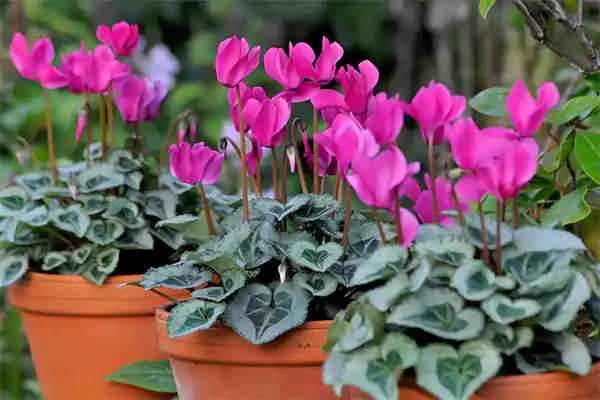
The most common indoor variety, Cyclamen persicum, features large, colorful blooms in pink, red, and white shades. Its heart-shaped leaves with silver marbling are its main attraction. Native to the Eastern Mediterranean region, this cultivar grows best in cool, indoor temperatures.
Hardy Cyclamen (Cyclamen hederifolium)
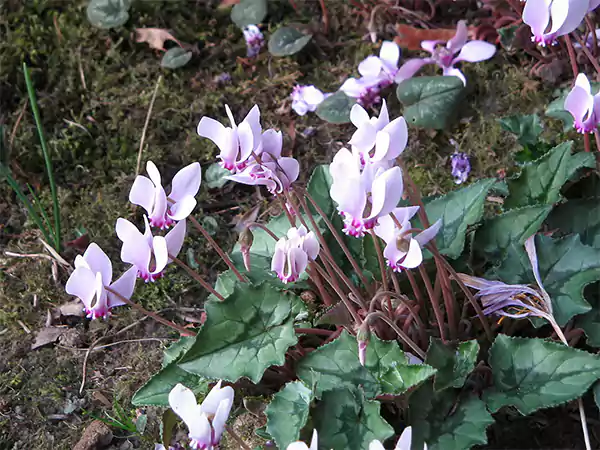
Cyclamen hederifolium is a hardy outdoor species that produces fragrant pink flowers in spring and white flowers in autumn. I love its ivy-shaped leaves that mostly appear after flowering, making it an ideal and visually appealing addition to my front lawn. This genus is native to the Northern Mediterranean region.
Eastern cyclamen (Cyclamen coum)
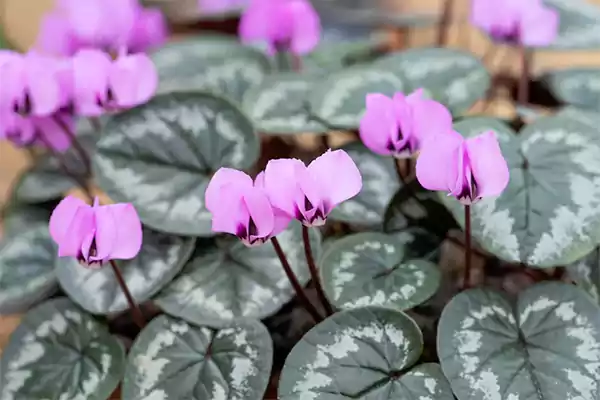
A winter-blooming variety, Cyclamen coum, offers small, rounded leaves and vibrant magenta or purple flowers. Usually blooms from late winter to early spring, this Cyclamen species is perfect for woodland gardens. This is a hardy perennial and can even tolerate frosty climatic conditions.
European Cyclamen (Cyclamen purpurascens)

Known for its strong fragrance and evergreen nature, the European Cyclamen mainly blooms in summer and grows best in cooler and shaded spots.
The deep purple pink flowers stand out beautifully against the dark green foliage, creating a stunning contrast. Native to Europe, Northern Italy, and Slovenia, this cultivar remains unharmed in winter frost.
Greek Cyclamen (Cyclamen graecum)
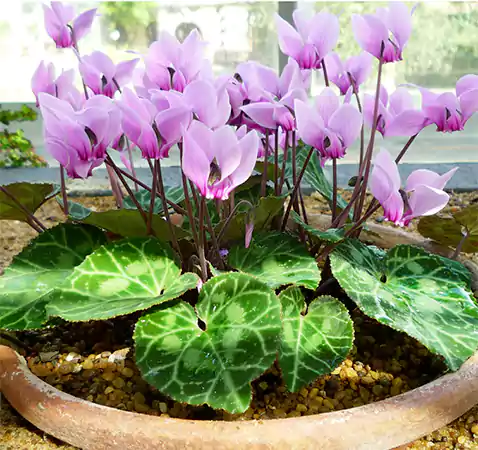
As the name suggests, this stunning variety is native to Greece and is a perennial plant with heart-shaped, dark green leaves. The intricately patterned leaves of the genus are its focal point of attraction. Its vibrant flowers, ranging from dark pink to purplish pink, make it an ideal ornamental Cyclamen variety.
From popular florist Cyclamen to hardy perennials, each cultivar brings its own beauty and resilience. Understanding its different types allows me to choose the perfect one for my front lawn, adding year-round charm to my plant collection.
Scientific Classification of the Cyclamen Plant
Whether you are just a garden enthusiast or an experienced botanist, understanding the botanical background of the genus is essential for providing the correct growing conditions. Allow me to quickly walk you through the scientific classification of Cyclamen.
| Scientific Classification of Cyclamen Plant | |
| Kingdom | Plantae |
| Clade | Tracheophytes |
| Clade | Angiosperms |
| Clade | Eudicots |
| Clade | Asterids |
| Order | Ericales |
| Family | Primulaceae |
| Genus | Cyclamen |
| Botanical Name | Cyclamen |
Cyclamen is a genus of 25 flowering species. All of them are perennial in nature and are commonly known as sowbread or swinebread. Most of the Cyclamens have a tuber from which the leaves, flowers, and roots grow.
Caring For Cyclamen in Different Seasons
Although Cyclamen are said to be low-maintenance and most of them are active during winter, they need special care during different seasons of the year.
Winter (Active Growing Season)
Keep the plant in a cool, shaded room. Avoid placing them under direct heat. The ideal temperature to maintain for Cyclamen indoors is between 50°F and 60°F. Water is only required when the topsoil feels dry. Keep the soil evenly moist, not soggy.
Summer (Dormant Season)
Cyclamen tend to shed their leaves during this season. Adjust the frequency of the water during the summer and allow the plant to rest. Do not use any kind of fertilizer during the dormant season, as it can deteriorate the soil quality and kill the plant.
Spring and Fall
During spring, the leaves of the plant become yellow and gradually fall. Reduce the water frequency to a minimum, and place the pot in an area where there is no light and protect it from rain. Once you notice fresh leaves emerging during fall, start watering again. Move the plant back to a light spot, preferably near a south-facing window.
Only with the right seasonal care, Cyclamen will reward you with beautiful year-long blooms. These attractive perennial garden plants can also make stunning ground covers if given proper attention.
Cyclamen Photo Gallery: Lush Greenery Through My Lens

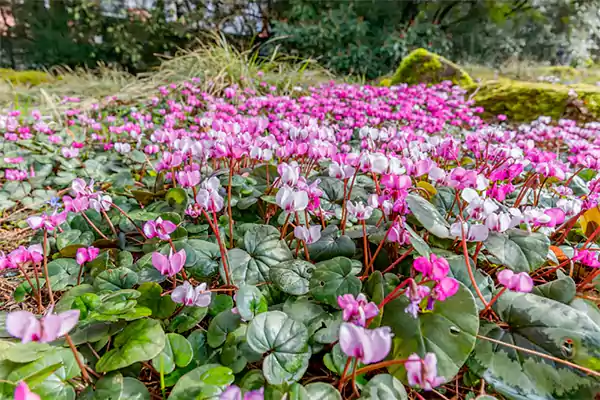

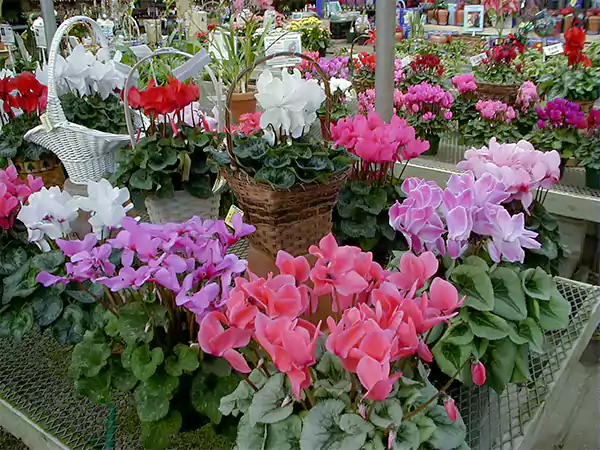
Conclusion
Caring for the Cyclamen plant is a rewarding experience once I understood its natural needs. Though it looked delicate in the beginning, once I provided the genus with the right environmental conditions, depending on the season, I witnessed flourishing blooms.
Now it has become more than a routine for me. It is now a bond that I have formed with right care and understanding.
How do you care for indoor Cyclamen?
To care for a Cyclamen plant indoors, place it in a cool room with bright indirect light. Keep the soil evenly moist but avoid waterlogging.
Do Cyclamen like sun or shade?
Cyclamen prefer growing under bright, indirect sunlight. If you are planning to grow it indoors, try placing it near an east or north-facing window.
What do I do with Cyclamen after flowering?
After flowering, Cyclamen tend to shed their leaves in their dormant period. Adjust the water frequency and allow the plant to rest.
How to keep a Cyclamen happy?
Cyclamen is a low-maintenance plant. By simply providing the genus with the right growing conditions, you can keep it happy and thriving.
How often should I water the Cyclamen plant?
During the initial growing stage, Cyclamen needs frequent watering for optimal growth. Once the species is established, adjust the frequency depending on the place it has been planted.
Where is the best place to put a Cyclamen?
The best place to put a Cyclamen is in areas with cool temperatures and dappled sunlight, such as under big trees or shrubs, or preferably indoors.
- Cyclamen – Wisconsin Horticulture
- How to Grow Indoor Cyclamen – BBC Gardeners
- Cyclamen Plant, Flower, Facts – Britannica
